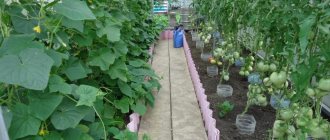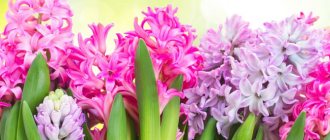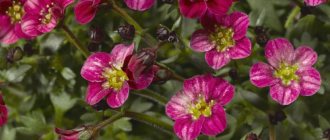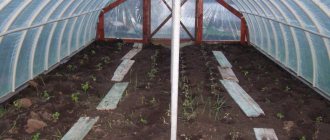Caring for dahlias is an important issue for many gardeners. That is why this issue will be discussed in the article.
One of the most beautiful, bright and long-blooming flowers. Here is a brief description of perennial garden plants - dahlias. This flower has 42 species and belongs to the Asteraceae family or, as they are also called, Asteraceae. Its main advantage is that it blooms from May - July until frost. But you need to be able to plant them correctly and care for them, which is what information will be provided in this article.
What a perennial dahlia looks like: photo
In common or colloquial conversation, the name of a flower is attributed to the masculine gender, but in the professional sphere it is associated, on the contrary, with the feminine class. That is, the ending “a” is added.
Interesting facts from history:
- The flower has two roots of origin. More precisely, its naming. The Latin version of "dalia" comes from the surname of the Swedish botanist Anders Dahl. But the Russian variation was obtained in honor of the geographer Johann Georgi from St. Petersburg.
- This type of flower was first discovered in Mexico back in the 15th century. Then the plant was used as food and helped against many diseases. Its most common use is in the treatment of epilepsy.
Biological description:
- Root system. In dahlias it is represented by root tubers or root cones. While the stem dies every year, the root tubers can live for several years. Therefore, the plant was given the status of a perennial flower. They have a thickened and fleshy structure. They do not have eyes that will give rise to shoots. That's why the next part is so important.
- Root collar . This is the transition from tubers to plant stems. In this place, the outer part dies off and the rudiments of future shoots appear. Therefore, this is the most important part of the plant.
Important! When digging in autumn, you need to be extremely careful with this part; it must not be cut off or damaged. Otherwise, the plant will simply die completely.
- Stem. They are straight and branched, and can be smooth or rough (depending on the species). The thickness ranges from 3 to 6 cm, and it is hollow inside. Therefore, heavy inflorescences and intense wind can easily break the plant. The height of the bush depends on the variety: Dwarf dahlias grow only 0.7-1 m in height
- Medium-sized ones can reach approximately 1.5 m
- But tall ones reach 2-2.5 m
Variety:
- Simple dahlias. Their flower stalks have one line of petals, up to 10 cm in diameter. The height of the plant reaches 45-60 cm.
Simple dahlias
- Anemoneaceae . They already have several layers of petals, in the middle of which their shape is slightly elongated and tubular. The diameter of the inflorescence is the same, but the height of the ground part can reach up to 90 cm.
Anemone species
- Chrysanthemum-shaped . The size of the plant is the same as that of anemone dahlias. The petals of the plant have a reed-like shape, twisted into a tube. Color can range from white to red, including yellow and pink tints. Reminds me of chrysanthemums.
- Collared. The size of the bush is slightly larger - 75-125 cm. The inflorescences really have the shape of a collar. The outermost flowers have one row of petals of the same color. But the core has a different color with short and twisted petals.
Collared dahlias
- Peony-shaped. The inflorescences are slightly larger - 12-15 cm, with straight and flat petals along the edges of the flower and with a tubular, inner core. The height of the plant itself is the same as the previous type.
- Decorative. The largest species, since the inflorescences can be from 8 to 23 cm, and the height reaches 60 cm.
- Globular. The name speaks for itself - the inflorescences resemble a ball in shape, but sometimes they can be slightly flattened with double and tubular petals. The dimensions of the flower are 8-15 cm, the ground part is 90-120 cm.
Globular dahlia
- Pompons. They have double inflorescences of a round shape, the diameter of which is above 5 cm. A distinctive feature is twisted marginal flowers with a blunt and rounded end. Bush height up to 120 cm.
Pompom look
- Cactus dahlias. The inflorescences also have a double shape, with a diameter of 8-25 cm. The height of the stem reaches 150 cm. The distinguishing feature is narrow and pointed, twisted marginal flowers.
cactus species
- Semi-cactus . The dimensions of the plant are the same as in the cactus version. But the marginal petals are slightly curled away from the middle of the core. Nymphaeaceae . Very similar to water lilies. The inflorescences are double and regular in shape. Their diameter ranges from 7 to 20 cm, the height of the bush can be up to 135 cm.
Important! There are even black dahlias. Or rather, red and black. The merit of this color is that the plant contains a large amount of pigment - anthocyanin. It is this that saturates the plant in red, blue or purple color. And a large percentage of it creates a black tint.
When is it time to plant tubers in spring?
Planting of dahlias begins when the threat of spring frosts has passed and the soil has warmed up to +10... +15 °C. In different regions, this period falls on different dates, for example, in the Krasnodar region it is the end of March - April, the Rostov region - the beginning of May, the middle zone - the end of May - the beginning of June, Siberia, Primorye, the mountainous Urals - the beginning of June. Even within the region there are late and early springs, the dates may shift.
Some gardeners are guided by folk signs. Dahlias are planted after bird cherry blossoms and at the same time or after mass planting of potatoes, and then under temporary shelter in case of possible frost. If you want to do without shelter at all, then plant dahlias at the beginning of summer, and start germinating their tubers 1-2 months before.
Boarding days
For those who decide to grow dahlias in their flowerbeds, it is worth taking care of the planting material in advance. If there are already plants in the flower garden, they are trimmed and prepared for winter storage. When a gardener first decides to plant dalia, it is better to prepare the tubers in the fall. Planting material can be asked from neighbors or friends, or purchased at a garden center. In the first case, it will always be known which flower will grow from the planted tuber. In addition to the selected variety, the beginning and splendor of the decorative phase are influenced by favorable days when it is advisable to plant dahlias.
The tuberous rhizomes of dalia are represented by roots with a neck and the lower segment of the central shoot. Often, flower growers (due to lack of experience) cut off such parts and plant them in the ground, and throw away the rest - the sprouts will never appear.
According to the lunar calendar
It is scientifically known that the Earth’s natural satellite is capable of influencing not only atmospheric phenomena. It affects human biorhythms, growth rate and resistance to plant diseases. Every year, more and more gardeners draw up a work schedule for their garden plots according to the relative positions of the planet and satellite. The lunar calendar will tell the gardener when it is better to drive out the seedlings and plant young specimens in the flower garden.
Favorable days for planting dahlias in 2020
| Month | Day |
| March | 12-17, 22-25 |
| April | 6-8, 20-26, 29, 30 |
| May | 6-8, 14-17, 21-23, 31 |
| June | 1, 2, 9-11 |
| July | 6-8, 12-15, 22-29 |
Regional influence
The sowing periods are influenced by the climatic features of the zone and the topography of the territory. Within the boundaries of one settlement, the soil warms up unevenly. On the hill on the southern side of the slope the soil will thaw faster than in the lowland. For dahlias, planting days begin with the establishment of consistently warm weather without night frosts. Dropping the mercury below 0 °C can completely destroy the plant.
In the Moscow region and the middle zone, tubers are planted in the middle or end of the month. If the winter was warm and the spring was early, then the procedure can be performed a little earlier - in the first days of the month. However, during this period there is a high probability of night frosts, which means that in pursuit of early flowering it is worth preparing covering material in advance. It will help, if necessary, to quickly protect the bushes from the effects of cold.
In the Urals and Siberia, where the climate is more severe and summer comes much later. Dahlias are transferred to the front garden in the second decade of summer. In June it will reach temperatures of 15 °C, when the plant can develop confidently. Some gardeners cultivate dalia in seedlings, immersing the tubers in containers. This technique allows you to transfer an already strengthened specimen to the rays of the sun.
In warm, even hot regions, it is not advisable to delay transplanting a representative of a flowering crop. In a warm winter with little snow, the soil will quickly warm up and dry out. The flower is sent to the garden in mid-late April. If spring warmth has arrived early and frosts are not expected, it would be optimal to perform the procedure at the beginning of the month. In this case, the dahlia will delight the gardener with its flowering a little earlier.
Exquisite bushes with double flowers of the “Jolly Fellows” variety are sown directly into the ground in areas with warm agroclimatic conditions. This is done in May after the mercury column reaches stable positive values.
When to start preparing the roots of perennial dahlias for planting after winter: planting dates
Dahlias are heat-loving plants. They are terribly afraid of drafts. By the way, take this into account when choosing a landing site. They need to be taken out of a cellar or other storage place when the earth is already sufficiently saturated with heat.
Consider your latitude:
- in the southern regions, tubers need to be prepared from the end of April
- in a mixed natural zone this period falls in the month of May
- but in the northern area it’s the beginning of June
Important! The air temperature should not be lower than 18-20°C.
Spring pre-planting work with dahlias
Dahlias are among the most beloved tuberous plants and one of the most striking autumn accents in garden design. But low frost resistance allows you to grow luxurious stars only by digging them up for the winter. The need to keep plants indoors and annually plant and dig up rhizomes is a small price to pay for their luxurious flowering. But growing dahlias is not just about planting or digging these plants.
Constant monitoring is the most important point in caring for dahlias. Even when the rhizomes overwinter, they need to be looked after: regular inspections, culling, control of lesions, timely correction of maintenance conditions - these are the measures thanks to which dahlias can wait until the new season.
In winter they are checked as often as stored crops. Of particular danger is the period of the beginning of the calendar spring, when changes in temperatures, humidity levels, and fluctuations in conditions often lead to an increased risk of rhizomes being damaged by fungal diseases or their premature germination.
The main stages of preparing dahlias for planting
Preliminary preparation of dahlias for planting is a set of measures that allow plants to adapt to warm conditions and activate the processes of growth and development. In regions with mild winters, there is no need to germinate rhizomes, but in the middle zone you cannot do without it.
Thanks to spring preparation and germination, the growing season of dahlias begins not at the time of planting, but several weeks earlier. Accordingly, the waiting time for flowering is reduced and the period when it can be enjoyed before the arrival of autumn cold increases.
Spring preparation of tubers includes several stages:
- Adaptation of dahlias to the conditions in which they will germinate;
- Inspection and processing of rhizomes;
- Germination of dahlia rhizomes before planting;
- Preparing for landing.
Optimal timing for germination
Germination of dahlias takes a fairly short period. To reach the stage of development at which plants need to be transplanted into the soil, 10-15 days are enough. In accordance with this, the start time for spring preparation is selected - 14-20 days before the expected planting date.
In the middle zone, germination is considered optimal at the end of April, beginning or mid-May (if gardeners are not ready to cover dahlias for earlier planting). The milder the climate, the earlier the dahlia rhizomes begin to awaken.
In the south, the start of preparing dahlias for planting can be postponed until 6-8 days before planting, and the third point - germination - is removed from the plan, leaving only clearing, disinfection and preliminary adaptation.
You also need to be guided in choosing the timing of germination based on the condition of the rhizomes: when the buds begin to swell, you cannot hesitate and continue to keep the dahlias in the dark and cold, because the shoots will be very fragile and it will be very difficult to preserve them before planting.
If the rhizomes show signs of awakening in March or April, they need to begin to be prepared for planting, at least in boxes or containers.
Features of awakening purchased dahlias
The timing is easier to control when using your own dahlias, whose condition is checked during the winter. If you buy new varieties, then you should look for rhizomes only from the second or third decade of April, so that you can make full preparations for planting.
Buying dahlias earlier, there is a higher risk of not keeping the plants until the required date. When choosing planting material, you should ensure that the tubers are in the dormant stage: any signals about the start of growth, loss of tissue density or the appearance of sprouts are undesirable. Purchasing awakened root tubers will lead to the fact that the plants may not survive planting and will not be viable due to their weakening.
Dahlia flowering. ©Beate Zoellner
How to select the right dahlia tubers for planting?
There is nothing complicated or supernatural in this process. It is necessary to remove dried tubers and remove damaged areas by cutting. The main thing is to treat the places of “trauma”. Most often, ordinary brilliant green, a weak solution of potassium permanganate, or ash are used. The last material should be carefully rubbed over the required area.
Tuber processing
- It’s better to place all the tubers in a weak solution of potassium permanganate for 30 minutes to 1 hour.
- Experienced gardeners have noted another method - an ash solution. You need to pour ¼ bucket of ash with cold water and leave for a day. Top water and use to disinfect tubers. They need to be placed for 2-3 hours.
- Those tubers that do not contain growth buds also require special attention. They are attached to a common center with thin roots. After planting in flower beds they rot. Therefore, trim them without regret; it will not cause damage to the bush.
Tuber preparation
When starting germination, the tubers are cleared of soil and washed with water. Then all rotten or dead parts are removed. Small tubers that are supported by thin roots are useless due to the lack of growth buds. Such thickenings should be removed, because After planting in the ground they rot. Manipulations are performed with a sharp knife, capturing some healthy tissue. It is advisable to lubricate the sections with brilliant green, and then sprinkle them with charcoal or activated carbon.
On a note! Often, tubers are coated with wax or clay before being sent for storage. This protective layer is removed in the spring by gently tapping the surface.
After clearing, the tubers are immersed for 30 minutes in a 1% solution of potassium permanganate. The disinfection procedure prevents the development of fungus and destroys putrefactive bacteria. Dahlia tubers are dried for 24 hours to form a protective layer on the wounds. To do this, they are placed in boxes in one layer and placed in a bright, ventilated place.
How to properly divide and process dahlia tubers for planting?
After small shoots have appeared, you need to start dividing the roots. Some gardeners carry out this operation in the fall. But practice shows that in this case, the damage to planting material increases several times due to rotting or drying out.
- The root, so-called “mother’s nest” must be divided into separate segments with a sharp knife. Each of them should have a root collar and 1-2 growth buds.
- There is no need to leave extra buds. Otherwise, the planting will give all its juices to the development of extra stems, and not to the creation of inflorescences. Then the flowers will turn out small and weak.
Important! If there are a lot of buds on one tuber, then it is better to cut the root in half. The main thing is to equally divide the root collar. In this case, you will get propagation of dahlias by cuttings.
- After which, the tubers are again placed in pots. Now you need to ensure regular watering. The temperature should be reduced to 15 °C. After they take root, dahlias can be planted in open ground.
- It is better to carry out the watering procedure using a spray bottle. Otherwise, the tubers may rot.
Buying tubers in bags
When buying dahlia tubers in a store, be careful. If possible, carefully examine the tubers; sometimes the bag contains a lot of broken, dried tubers. You should not buy large nests of hummocks; they will grow a lot of tops and few flowers. When purchasing, pay attention to the size of the tubers, as well as
- tubers should be dense and elastic;
- have a light brown color;
- there are no dry or fallen tubers in the bag;
- there is a small piece of the root collar - the place where the root turns into a tuber;
- the presence of growth points - sprouts.
Based on these signs, you will buy healthy planting material. And then the purchased nodules are prepared for planting in the same way as written earlier.
Is it necessary and in what to soak the roots of perennial dahlias before planting?
Yes, dahlias need to be soaked 2 hours before planting. Most ordinary water will do. This procedure is necessary so that the soil is well saturated with moisture and the roots are easily removed from the container. If there are shoots higher than 10 cm, or additional sprouts appear, they need to be carefully broken off. Don't leave more than 3 stems.
Important! Before planting, try to gradually move the plant into fresh air. Start with 10 minutes, gradually increasing the time by 50 minutes. This should be done a few days before planting in open ground.
When to get dahlias for cuttings
For cuttings, dahlias should be taken out of the basement in the last ten days of February - the first ten days of March. Germination of these flowers is carried out in containers filled with nutritious soil mixture. You can buy it in specialized stores, but you can prepare it yourself. Several recipes for such substrates:
- high peat is mixed with river sand in a ratio of 1:1;
- purchase a special soil - “coconut”;
- sawdust (not softwood) is mixed in equal parts with river sand.
In any of these mixtures, flower nodules will feel great. After 2.5-3 weeks, the first shoots will appear. When their height reaches 12-14 cm, you can cut the cuttings.
How do you treat the soil for perennial dahlias before planting?
Chernozem needs to start fertilizing in the fall. To do this, treat the area with humus. In the spring, the top layer needs to be mixed with compost and gold. To do this, start the rake.
- Please note that dahlia loves neutral or slightly acidic soil. Alkaline soil can be amended by adding some peat moss in the spring.
- Slaked lime will help reduce acidity.
Important! Maintain crop rotation! You cannot plant tubers in the same place for more than 3 years. Spores of fungi and diseases, as well as remains of rot, remain in the ground.
- Also, do not plant dahlias with asters. They are susceptible to the same diseases, so they can transmit them to each other.
Scheme and depth of planting dahlias in a flowerbed: description
Proper planting is another important key to healthy growth and long flowering of dahlias.
- You need to dig holes that are three times the size of the tubers themselves. Also note that you need to add 7-10 cm for fertilizers and deepening the root system.
- The distance between the holes directly depends on the dahlia variety. For low-growing plants it should be 30-50 cm, but for tall or giant dahlias it should be 80-90 cm.
- If the soil is very dense, then place some drainage at the bottom of the hole. One shovel of gravel or crushed stone is enough.
- Humus, a little sand and fertilizer are also laid. All this is covered with earth and then watered well. You can also add bone and dolomite meal. A handful of ash will not be superfluous. The entire mixture should occupy half of the hole.
- The tubers are placed in the hole so that the eye is directed upward. The rhizomes are covered with 2-5 cm of soil.
Planting dahlias in a flower bed
- By the way, for large bushes, immediately take care of installing support.
- Seedlings need to be watered abundantly and only with warm, but not hot, water. When the shoots grow and the ground settles a little more, gradually add soil. Until the hole is filled to the top.
- Be sure to mulch the soil. To do this, use peat or tree bark.
- When the shoot appears, it needs to be watered as needed. Before this, watering is carried out a little more often.
Soil selection and preparation
Dahlias love loamy or well-fertilized sandy soil. In autumn, it is necessary to dig up the soil to a depth of 30 cm. At the same time, enrich the soil with 15-18 kg of rotted manure and 25 g of superphosphate per 1 square meter. Two or three weeks before planting, the distant area is dug up again, but only potash fertilizers (potassium sulfate or nitrophoska) are applied.
Slightly acidic or neutral soil is ideal for dahlias. To reduce acidity in the fall, add slaked lime in the amount of 300-800 g per 1 square meter. m.
If you need to increase the water permeability of heavy soil, then use peat or coarse sand.
Dahlias do not tolerate drought, so the planting site should not be adjacent to large trees that take away moisture and nutrients. The planting site should be near buildings or bushes to protect the plant from the wind. Lowlands and swampy areas are extremely undesirable.
What and how many times should I feed dahlias after planting?
You need to take care of fertilizing in the fall. Then you should add fertilizer to the soil before planting. When you plant the tubers directly, each hole is fertilized separately. After which the feeding of the plants themselves begins.
- The first feeding should be carried out no earlier than 7-10 days after planting. But the tubers must have time to take root. The safest and healthiest are mullein infusions. You need to dilute 1 kg of manure in 10 liters of water.
- You can also use superphosphate and ammonium nitrate. Requires 20 g of substances per 10 liters of water.
- Ash, which must first be kept in water for a day, has proven very good.
- During the spring, 3-4 feedings are carried out with an interval of 10-14 days.
- In summer, potassium and phosphate fertilizers are more needed. To do this, take 50 g of the substance and 3-4 handfuls of ash per 10 liters of water. No more than 4 such procedures should be carried out during a period.
- The last feeding is carried out after the end of flowering. For this, potassium sulfate is used at a rate of 30 g of the substance per bush.
How often to water perennial dahlias after planting in open ground?
Plants are watered once every 2 weeks. Especially, monitor the condition of the soil in the heat and during the period of bud formation. If there is a lack of moisture during the ovary of inflorescences, then the flowers will be small and ugly. Therefore, during this period, watering increases by 1.5-2 times. After flowering begins, watering is reduced and done as needed.
Try to carry out the watering procedure in the evening or early in the morning, when the dew has subsided. Also, do not pour water on the leaves of plants. On hot days this can cause burns. And excess moisture will lead to root rot.
Difficulties you may encounter when growing dahlias
Lack of proper formation is the most common reason why dahlias do not bloom. But if growing conditions are unsuitable, other problems may arise. For example, yellowing of the lower leaves and the formation of spotting.
Most often, these ailments appear as a result of a lack of nutrients (they are replenished with the help of fertilizing) and growing flowers in soil with an inappropriate pH. Please note: dahlias prefer slightly acidic soil.
Dahlia bushes are sensitive to excess moisture, especially at the beginning of the growing season. Their suction roots die and the tubers rot. To restore the root system of plants, they are watered with water containing a root formation stimulator (Kornevin, Heteroauxin).
- Why dahlias don't bloom - 7 possible reasons
What happens to dahlias that refuse to bloom and cease to delight with bright colors? You will find the answers in the article.
Reproduction of dahlias: description
There are five ways to propagate dahlias. One, the most common one, was indicated above - this is division by tubers. Therefore, we will omit detailed information in order not to repeat ourselves.
- Division by tubers. It is worth adding just one more important information - this procedure should be carried out every year. This helps rejuvenate the plant and prevents the formation of small flowers.
- Cuttings. This was also mentioned a little above. This method increases the ability of dahlias to resist disease. And it should be noted that the growth of the flower increases significantly. After dividing the tuber in half, it is planted again in the ground. It is important to ensure that the root collar remains open. You need to water constantly to keep the soil moist.
- The temperature should be up to 25 °C. When shoots appear, reduce it to 15-17°C. At the same time, move the box with seedlings to a bright place. If the weather is cloudy, then you need to take care of additional lighting.
- When the sprouts grow to 10 cm, they are cut with a stationery knife. This should be done obliquely, leaving a couple of millimeters at the base. This will allow you to grow several shoots.
- After this, the cuttings are placed for three weeks in a moist substrate in separate containers. Make sure there is sufficient heat and light. During this period, they need to be adapted to the environment, gradually increasing the ventilation time.
- They need to be planted in pots or containers with good drainage (2-3 cm of gravel is enough) and nutritious soil. Cuttings should be planted 2-3 cm into the ground, at a distance of 5-7 cm from each other.
- At first, it is necessary to provide abundant watering. It is advisable to use a solution of manure, mullein or litter. After the first leaves appear, the cuttings can be planted in open ground or pots.
- To do this, cut off the inflorescences in the fall and leave them to dry in a dry and well-ventilated area.
Dahlia propagation
- Reproduction by grafting. This method allows you to create very large and beautiful plants, but, unfortunately, it is very painstaking. You need to take a healthy, but unsuitable for planting, tuber and the required cuttings.
- Wash the root vegetable, dry it and make a cylindrical hole in it. And the stalk itself needs to be sharpened at the bottom. Then insert the cutting into the opening of the tuber.
- The junction must be tightly wrapped with a cotton or woolen rope. After this, you can plant them in the soil.
- If you notice an unusual bud on a bush, cut it off and cut lateral inflorescences 10-12 cm long from it.
Germination of root tubers
Germinating dahlias is an important step for obtaining abundant flowering in the early stages. When purchasing planting material in a store, you need to pay attention to the presence of “eyes”. Tubers need to be provided with suitable temperature, humidity and lighting. They are germinated in several ways:
- in a box with substrate;
- in the package;
- in the trench.
Germination of tubers in boxes
To germinate tubers, use wide, shallow boxes. They can be made of plastic or wood. Ceramic pots will also work. In order for the tubers to sprout, you must perform a number of actions:
- A film is placed at the bottom of the container, then a small layer of sawdust, loose soil or peat is poured.
- The tubers are placed freely in the box, sprinkled with the selected substrate and irrigated with a spray bottle.
- Plantings are placed on a window, glassed-in loggia or in a greenhouse with good lighting. When cool, the sprouts are strong, so dahlias are sprouted at a temperature of +16...+22°C.
- Planting material is regularly moistened with warm water, preventing the soil from drying out. Watering should be moderate so that the tubers do not rot.
Important! Do not sprinkle soil on the root collar of the tubers. It should protrude above the surface so that the buds begin to grow faster.
If all conditions are met, sprouts will appear in 5-7 days. Coconut fiber can be used to germinate dahlias. The substrate is sold in the form of chips, briquettes or tablets. Before use, it is recommended to pour hot water over it, cover with a lid and let cool. You can make a soil mixture from coconut fiber at the rate of 1 kg per 7 liters of soil.
Growing dahlias in bags or trenches
Put tubers, a little sawdust in plastic bags and moisten them. Dahlias are left in a well-lit place. Moisture and warmth promote the awakening of buds and the formation of sprouts. Planting material is regularly inspected for rot. After 10 days, the plastic bags are opened to spray the tubers again with water. The plants will be ready for planting in 7-8 days.
If there is no space in the house for boxes, root tubers can be sprouted on the site by placing them in a trench. This method is more labor-intensive, but gentle on plants. It includes the following steps:
- In the garden, they dig a trench with a depth of a spade bayonet and a width of 40 cm.
- The rhizomes or cuttings are laid out so that they do not touch each other. Different varieties are marked with tags.
- Plantings are covered with loose soil. Metal or plastic arcs are installed over the trench, onto which the film is stretched. To prevent it from flying off in gusts of wind, stakes are driven in or bricks are placed along the edges.
- There is no need to water the soil, because... in spring it is saturated with moisture. After 2-3 weeks, sprouts will appear. The cover is removed and the flowers are grown as usual. If necessary, the sprouted tubers are transplanted to another place.
Diseases and pests of tuberous and perennial dahlias: description, treatment
There are many diseases that dahlias are susceptible to. But they all have a fungal, viral or bactericidal nature. Diseases and their treatment.
Fungal diseases
- Gray rot . It starts with brown spots on the leaves, gradually turning them gray. Then the entire plant is covered with this coating and it dries out. Cannot be treated! The outer part is completely cut off and burned. After harvesting, the tubers are treated with potassium permanganate.
- To cure the plant, you need to pick off the damaged leaves and treat the bush itself with copper sulfate.
- The plantings are torn out and burned, and the soil is limed. The main reason is heavy and acidic soil.
- Cannot be treated. The plant is removed and the soil is treated with Bordeaux mixture. The plant cannot be planted in this place for at least three years.
- For treatment, the soil must be treated with photospirin and potassium permanganate.
Fungal diseases
Viral diseases
Not subject to therapy. Plantings need to be dug up and completely incinerated. The land becomes unsuitable for planting flowers for three years.
- Viral mosaic is expressed by light spots of irregular shape. Over time, they wrinkle and wither.
- Oak mosaic is characterized by light green stripes on the leaves.
- Ring spot - pale green oval spots appear on the leaves.
Bacterial diseases
They are also not treatable. The bushes are removed and burned. The soil needs to be treated with copper sulfate and lime. Plants cannot be planted on affected soil until they are 5 years old.
- Cancer is expressed as white growths on the lower part, then they darken and rot.
- Growth cancer is expressed in thin roots and shoots, which are observed in large numbers. Tubers cannot develop.
What pests attack dahlias:
- Aphids most often attack young seedlings. The plant becomes covered with a sticky coating, gradually turning yellow and drying out. It is necessary to treat with soap or garlic solution, as well as onion peel tincture.
Dahlia pests
- Slugs love dahlia flowers and leaves. To fight them, you need to place bait in the form of pieces of slate in the flowerbed. In the morning, when you find them, destroy them. You can also sprinkle eggshells or coarse sand around the seedlings. This will make it difficult for them to move.
- It is possible and necessary to fight such pests. Any appropriate store-bought preparation or tinctures of wormwood and celandine are suitable for this.
Rules for storing dahlia tubers in winter: description
Large tubers should be divided into smaller parts. To do this, you need to arm yourself with a sharp knife, which should be preheated over a fire. This will act as a disinfection effect. Be careful with the molar necks - they cannot be damaged.
- After which the tubers are inspected for the presence of red or yellow spots and other damage. Only whole and healthy rhizomes should be left.
- The optimal storage temperature is 1-5 °C. Therefore, the ideal place would be a basement or cellar.
- The tubers are placed in wooden sawdust. If there is high humidity in the room, then they are replaced with sand.
Division of rhizomes
Root tubers are divided annually to renew them. Otherwise, the plants will throw out a lot of shoots and build up green mass to the detriment of flowering. This procedure is best carried out in the spring. If the rhizomes are divided in the fall, the tubers may dry out or rot. The procedure begins when the growth points hatch. It should be borne in mind that all the buds are located not on the tubers, but on the root collar.
Each rhizome is carefully cut so that a piece of the old stem and root collar with 1-2 buds remains on the resulting parts. Bushes with so many shoots will be lush and the rhizomes will be strong. If there are more growth buds, they are not broken off, but carefully cut off with a sharp knife. It is recommended to treat the wounds with wood ash and wait until they dry. The germinated cuttings are planted in a permanent place in the first half of June.











